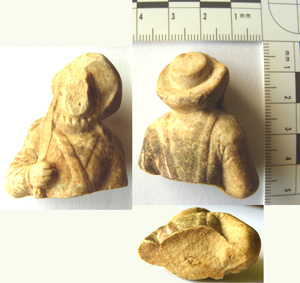Figurine

Click ^ for larger image.
This figurine is something of a mystery, but the most likely view is that it is 17th century in date, and Dutch or Flemish in origin.
The item and photographs of it have passed through many hands in the effort to give it a date and meaning. Very often people recognised some or other feature that they identified as belonging to their own interest. The prominent ruff, for example suggested a late Tudor date, say around 1530, but that didn't match the other costume elements such as the crossed straps which became a feature of English military wear common with the Cavaliers during the English Civil War a century later. Was it Parian Ware, a popular white pottery developed in the mid 19th century that was used to produce a wide range of delicate figurines, or some other substance altogether?
The material of which the figurine is made is still uncertain. A visual inspection indicates it's almost certainly carved stone rather than cast pottery. It's likely to be a metamorphic rock such as marble, but it has an MOH rating close to 7, which is harder than ordinary marble (more like quartz) and therefore much more difficult to carve.
It appears that somebody went to great effort in sculpting this figurine, and it would be wonderful to know more of its history. For now though, we still have more questions than answers.
With thanks to Simon Cawley for help in bringing this intriguing local curiosity to our attention.
Material: stone
Period: Post Medieval
Find spot: Brislington Brook, Nightingale Valley
Exhibit contributed by Leila Dennys
Text written by Ken Taylor
Photographer: Ken Taylor
Acquisition number: 190206a1